Share this
Creating the V Shape Face by Jaw Reduction Surgery in Singapore
on July 15, 2016
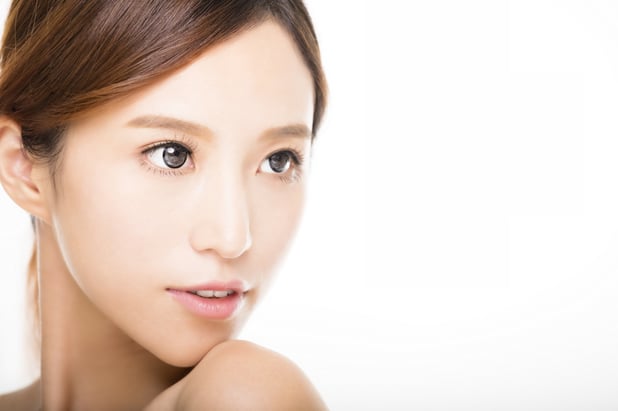
Twenty-four years ago, when I was preparing my Master’s thesis, I reviewed a lot of literature on facial norms. I needed to look at what constitute a “normal” face. As it turned out, most of the publications were actually based on aesthetic ideals.
Naturally, this is because surgical literature are biased towards surgically enhancing facial proportions and features to achieve an aesthetic outcome. Somehow, “normal” is not what patients who are ready to subject themselves under the knife wanted. In Singapore, we are subjected to chiseled angular facial features of the West and the V-shape face so desired in Asia.
East v West..
Aesthetics is abstract. It is dependent on the judgment of the assessor and is subject to all the personal prejudices of the individual, his cultural background and social environment. It is also subject to changing norms and preferences in society over time. Twenty years ago, before the advent of K-pop and the V-shape face, there was not a lot of difference in aesthetic preferences between Asian and the West. In fact, one of the criticisms back then was that Asians were trying to change their faces to look more like Caucasians. There may be some truth in that. However, what critics overlooked was that Asians were not trying to change their faces to look like any Caucasian, but only the good-looking ones.
Beauty through the ages...
Facial aesthetics have been studied since ancient times. While there are variations in different cultures and through different times, there are some general principles that have always remain constant. Proportionality and symmetry are always critical for aesthetics. In planning for cosmetic jaw surgery, regardless of the patient’s cultural background, I always strived to achieve good proportions and symmetry.
Chiseled vs Softened...
Beyond that, I need to understand the patient’s aesthetic sense. There is no right or wrong, only preferences of the patient. To get a sense of the patient’s preference, I may asked them for a example of a celebrity that they think epitomizes their idea of an aesthetic face. There is a wide range of names that get mentioned, some whom I have not even heard of, which is not saying much as I am not into pop culture. In this spectrum of facial aesthetic features, I assign on the one end, faces like that of Angelina Jolie, who has angular and prominent features and on the opposite end of the spectrum, a face of the typical Korean actress, with the V-shape face and rounded facial angles except for the chin.
V Shape face rules in Asia....
Quite expectedly, most Asians prefer the V-shape face as they can identify more with a Korean actress than a Hollywood star. A Google search for “V shape face treatment in Singapore” yields many pages of websites of clinics offering such treatment.
However, the treatment that are usually offered comprises minimally invasive procedures such as dermal fillers and botox injections, thread lifts and radiofrequency tightening of the skin. While the minimally invasive nature of such treatment is attractive, the resulting change is also minimally noticeable. Which means that if there are prominent skeletal features, such procedures are only camouflaging them. Furthermore, effects of fillers and botox are not permanent and regular maintenance is needed. To effect real and lasting change, bony surgery is inevitable.
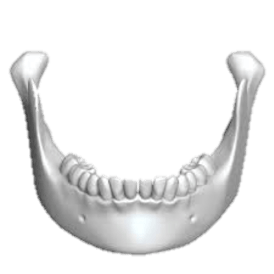
Jaw Reduction & Contouring Surgery
Central to the creation of a V shape face starts with the lower jaw. To be sure, the V shape is referring to the frontal appearance, just as what one will see in the mirror. For most people, the face is more U shape than V. In fact, many have a rather broad U. Somehow, like a fashion, most Asians have decided that V is more aesthetic than U, at least for an Asian and jaw surgery techniques to achieve that look have been developed.
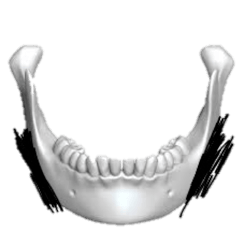 Mandibular angle
Mandibular angle
In most patients, the angle of the lower jaw is about 90 degrees to 100 degrees and is visible from the frontal view. By cutting away this angle and smoothing it out into a gentle curve, the jaw line rendered more feminine in profile view and the width of the lower face as seen from the front becomes narrower.
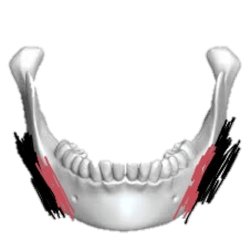 2. Mandibular body
2. Mandibular bodyThe body of the lower jaw immediately in front of the angle can also be reduced in thickness. The outer layer of bone is the cortical layer and this can be removed or trimmed down, further reducing the width of the face in front of the angle.
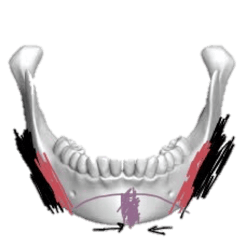 Chin
Chin
First, the chin is cut and separated from the lower jaw but still attached to the muscles to maintain blood supply. This chin surgery or genioplasty is the final part that completes the V transformation. Thereafter, the mid-section of the chin measuring about 5-10mm is cut away, dividing the chin into left and right halves. These two halves are then approximated together, thereby reducing the width of the lower face at the front-most part of the lower jaw. The chin is reattached to the jaw in a more forward position, thereby creating a small chin prominence. This increased projection also adds to the V-ness of the face.
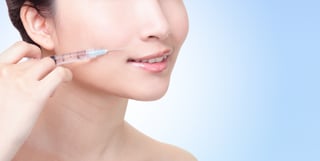 4. Botox
4. Botox
To complete the V transformation, neurtoxin injections into the masseter muscles may be needed in some cases. Most patients who have undergone bony surgery do not require such injections as the degree of change from surgery is usually quite dramatic already. However, in some patients with a low mandibular angle, the masseter muscles can be rather well-developed and may mask the effect of the surgery. In the past, masseter muscle reduction were done to reduce the muscle bulk but due to the risk of facial nerve injury and maxillary artery bleeding, it is mostly replaced by botox injection now.
However, the face is not made up of just on feature. Jaw contouring surgery to achieve a V shape by itself may not achieve the desired aesthetics as each part of the face needs to be assessed in relation with the rest. It is important not to neglect the other facial contours and features while attempting to create the V shape. Balance, proportionality and symmetry remain the cornerstone of facial aesthetics and should set the tone for cosmetic facial surgery.
Good Candidates for Botox Jaw Reduction
Below are the characteristics of good candidates for botox jaw reduction surgery:
Overdeveloped Masseter Muscles
You are considered a good candidate if you have overdeveloped masseter muscles that contribute to a square or wide jawline. This may be due to genetics, teeth grinding, or other factors.
Good Overall Health
You are considered a good candidate for the procedure if you are in good overall health and do not have any underlying medical conditions that may increase the risk of complications. It is important to discuss any medical conditions or medications with your surgeon prior to the procedure.
Realistic Expectations
You are also a good candidate if you have realistic expectations for the outcome of the procedure. While botox can reduce the size of the masseter muscles and create a more contoured jawline, it is not a permanent solution and will need to be repeated every few months to maintain the results.
No Allergies to Botulinum Toxin
You are a good candidate for the procedure if you do not have any allergies to botulinum toxin. It is important to discuss any allergies or sensitivities with your surgeon prior to the procedure.
No Pregnancy or Breastfeeding
Botox jaw reduction surgery is not recommended for women who are pregnant or breastfeeding. It is important to discuss any plans for pregnancy or breastfeeding with your surgeon prior to the procedure.
No Recent Facial Surgery
Botox jaw reduction surgery is not recommended for individuals who have had recent facial surgery or who have scars or other skin conditions in the area to be treated. It is important to discuss any previous surgeries or skin conditions with your surgeon prior to the procedure.
Good Dental Health
Good candidates for botox jaw reduction surgery are those who have good dental health and do not have any underlying dental conditions that may affect the procedure or the results.
The Benefits of Botox Jaw Reduction
This procedure has become increasingly popular in recent years, as it offers numerous benefits for individuals who are unhappy with the appearance of their jawline. Below are some of the benefits of botox jaw reduction.
Non-Surgical
Botox jaw reduction is a non-surgical procedure, which means that it does not require incisions or anesthesia. This makes it a less invasive option for individuals who want to improve the appearance of their jawline without undergoing surgery.
Quick Procedure
Botox jaw reduction is a relatively quick procedure that can be performed in a matter of minutes. Patients can typically return to their normal activities immediately after the procedure.
No Downtime
Botox jaw reduction does not require any downtime or recovery period. Patients can resume their normal activities immediately after the procedure.
Natural-Looking Results
Botox jaw reduction can provide natural-looking results that enhance the appearance of the jawline without looking overdone or unnatural.
Reduced Jaw Clenching and Teeth Grinding
Botox jaw reduction can also help to reduce jaw clenching and teeth grinding, which can cause headaches, jaw pain, and other symptoms.
Improved Facial Symmetry
Botox jaw reduction can help to improve facial symmetry by creating a more proportionate jawline. This can enhance the overall appearance of the face and boost self-confidence.
Long-Lasting Results
While the results of botox jaw reduction are not permanent, they can last for several months. Patients can maintain the results with regular touch-up treatments.
Minimal Discomfort
Botox jaw reduction is a minimally uncomfortable procedure that typically only involves a slight pinch or pressure at the injection site.
Safe and Effective
Botox jaw reduction is a safe and effective procedure that has been used for many years to treat a variety of cosmetic and medical conditions.
Possible Risks and Complication of Botox Jaw Reduction
While the procedure is generally safe and effective, it is important to understand the possible risks and complications associated with botox jaw reduction. Below are some of the possible risks and complications of botox jaw reduction:
Pain and Discomfort
Pain and discomfort are common after botox jaw reduction. Patients may experience swelling, bruising, and tenderness at the injection site. These symptoms typically resolve within a few days.
Uneven Results
Botox jaw reduction can create uneven results if the injection is not administered evenly on both sides of the face. This can be corrected with additional injections, but it is important to discuss any concerns with your surgeon.
Allergic Reactions
While rare, allergic reactions to botulinum toxin can occur. Symptoms may include itching, swelling, and difficulty breathing. If you experience any of these symptoms, it is important to seek medical attention immediately.
Nerve Damage
Botox jaw reduction can cause nerve damage if the injection is not administered properly. This can result in numbness, tingling, or loss of sensation in the face. While rare, it is important to discuss the risks with your surgeon prior to the procedure.
Infection
As with any injection, there is a risk of infection. Patients should follow all post-operative instructions to minimize the risk of infection.
Jaw Weakness
Botox jaw reduction can cause temporary weakness in the jaw muscles, which can affect chewing and speaking. These symptoms typically resolve within a few weeks.
Headaches
Botox jaw reduction can cause headaches, particularly in the first few days after the procedure. These headaches typically resolve on their own or can be managed with over-the-counter pain relievers.
Difficulty Eating
Following botox jaw reduction, patients may experience difficulty eating due to jaw weakness or discomfort. This is typically a temporary issue and can be managed with a soft diet.
How to Prepare for Botox Jaw Reduction
While the procedure is generally safe and effective, it is important to properly prepare for the procedure to ensure the best possible outcome. Keep the following basics in mind when preparing for botox jaw reduction:
Discuss Your Medical History
It is important to discuss your medical history with your provider prior to the procedure. This includes any medical conditions, allergies, medications, or previous surgeries. Your provider may recommend that you stop taking certain medications prior to the procedure to minimize the risk of complications.
Stop Smoking
Smoking can delay healing and increase the risk of complications after the procedure. It is important to stop smoking at least two weeks prior to the procedure and to avoid smoking for several weeks after the procedure.
Avoid Alcohol and Blood Thinners
Alcohol and blood thinners can increase the risk of bleeding and bruising after the procedure. It is important to avoid alcohol and blood thinners for several days prior to the procedure.
Follow Pre-Procedure Instructions
Your provider will provide you with specific pre-procedure instructions to follow. This may include avoiding certain foods or medications, washing your face with a gentle cleanser, and avoiding makeup or other skincare products.
Arrange for Transportation
Botox jaw reduction is a minimally invasive procedure, but it is important to arrange for transportation to and from the procedure. You may experience some discomfort or swelling after the procedure, which may affect your ability to drive.
Plan for Recovery
While botox jaw reduction does not require any downtime or recovery period, you may experience some swelling or discomfort after the procedure. It is important to plan for recovery by arranging for time off work or school, preparing a soft diet, and avoiding strenuous activities for several days after the procedure.
Aftercare Tips for Botox Jaw Reduction
While the procedure is generally safe and effective, it is important to properly care for the treated area after the procedure to ensure the best possible outcome. In this article, we will discuss aftercare tips for botox jaw reduction.
Avoid Touching the Treated Area
It is important to avoid touching the treated area for several hours after the procedure. This can help to minimize the risk of infection or irritation.
Apply Ice Packs
Applying ice packs to the treated area can help to reduce swelling and discomfort after the procedure. It is important to use a clean, cold compress and to avoid applying the ice directly to the skin.
Take Over-the-Counter Pain Relievers
If you experience discomfort or headaches after the procedure, over-the-counter pain relievers such as acetaminophen or ibuprofen can be helpful. It is important to follow the recommended dosage and to avoid taking aspirin, which can increase the risk of bleeding.
Avoid Strenuous Activity
Strenuous activity can increase blood flow to the treated area and may affect the results of the procedure. It is important to avoid strenuous activity for several days after the procedure.
Eat Soft Foods
Following the procedure, it may be helpful to eat soft foods such as soup, yogurt, or mashed potatoes. This can help to minimize discomfort and reduce the risk of irritation to the treated area.
Avoid Alcohol and Smoking
Alcohol and smoking can increase the risk of bleeding and may affect the results of the procedure. It is important to avoid alcohol and smoking for several days after the procedure.
Follow Post-Procedure Instructions
Your provider will provide you with specific post-procedure instructions to follow. This may include avoiding certain foods or medications, applying topical treatments, or using a special mouthguard.
Schedule Follow-Up Appointments
Botox jaw reduction typically requires follow-up appointments to maintain the results. It is important to schedule these appointments and to follow your provider's recommendations for touch-up treatments.
Frequently Asked Questions
The actual injection will take five to ten minutes. The visible reduction of the jaw muscles will become apparent after about three weeks.
The pain is similar to any other intramuscular injection. The needle is very thin and with some application of cold spray just before injection, the pain is minimal.
No special preparation is needed. It will be good to not have make up on your face.
The results usually lasts for six to nine months.
Yes. In fact, in many cases of patients with TMJ symptoms, botox injection is indicated as one of the treatment modality.
There is no downtime. You can return to work immediately.
There is no immediate reversal drug available. However, as the effect is not permanent, it will reverse automatically over six to nine months.
The procedure of injecting the botox will only take about five to ten minutes.
Share this
- Jaw Surgery (93)
- Dental Implants Singapore (90)
- Orthognathic Surgery (48)
- Replacing Missing Teeth (26)
- Missing Teeth Options (23)
- Underbite (23)
- Bone Grafting (21)
- Costs (18)
- Facial Aesthetics (18)
- Aesthetics (17)
- dental implants (16)
- corrective jaw surgery (15)
- BOTOX (11)
- Dermal Fillers (11)
- Wisdom teeth (10)
- Fixed Implant Dentures (8)
- Loose Dentures Singapore (6)
- Medisave (6)
- sleep apnea (6)
- Braces (5)
- Dental Pain (5)
- Dentures in Singapore (5)
- Loose Teeth (5)
- Tooth Extraction (5)
- jaw deformities (5)
- bimax (4)
- bone graft (4)
- maxillomandibular advancement (4)
- all-on-4 (3)
- bimaxillary protrusion (3)
- chin implant (3)
- facial asymmetry (3)
- full mouth dental implants (3)
- genioplasty (3)
- immediate implant (3)
- removal of an integrated dental implant (3)
- third molars (3)
- wisdom tooth surgery (3)
- My Dentures Don't Fit (2)
- VME (2)
- bone graft healing (2)
- distraction osteogenesis (2)
- medical tourism (2)
- obstructive sleep apnea (2)
- orthodontics (2)
- plastic surgery (2)
- CT guided dental implants (1)
- Double jaw surgery (1)
- Invisalign (1)
- Periodontal Disease (1)
- Permanent Dentures Singapore (1)
- before and after photos (1)
- facial trauma (1)
- fractured dental implant (1)
- oral appliance therapy (1)
- root canal treatment (1)
- veneers (1)
- vertical maxillary excess (1)
- September 2019 (2)
- July 2019 (2)
- May 2019 (2)
- August 2018 (1)
- October 2017 (1)
- September 2017 (2)
- August 2017 (1)
- June 2017 (2)
- May 2017 (4)
- April 2017 (1)
- March 2017 (1)
- February 2017 (3)
- January 2017 (3)
- December 2016 (1)
- November 2016 (2)
- October 2016 (4)
- September 2016 (9)
- August 2016 (5)
- July 2016 (11)
- June 2016 (14)
- May 2016 (6)
- April 2016 (2)
- March 2016 (1)
- January 2016 (7)
- December 2015 (10)
- November 2015 (4)
- October 2015 (9)
- September 2015 (7)
- August 2015 (1)
- July 2015 (6)
- June 2015 (3)
- May 2015 (7)
- April 2015 (5)
- March 2015 (8)
- January 2015 (5)
- December 2014 (7)
- November 2014 (7)
- October 2014 (6)
- September 2014 (8)
- August 2014 (5)
- July 2014 (7)
- June 2014 (8)
- May 2014 (9)
- April 2014 (10)
- March 2014 (6)
- February 2014 (8)
- January 2014 (3)
Subscribe by email
Email subscription


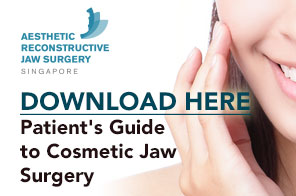

Comments (1)